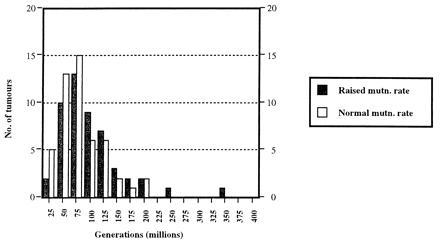Figure 2.

Model of tumorigenesis with two mutations required for tumor growth. The premises of the model are as follows. Given enough time, any stem cell will acquire the necessary mutations to become a tumor. In practice, organisms die before this occurs in nearly all of their stem cells. If, however, a stem cell acquires the necessary mutations exceptionally rapidly—whether by chance, after exposure to extrinsic mutagens, or as a result of an inherited tendency to cancer—a tumor will start to grow within an individual’s normal lifespan. We have taken a single stem cell and assigned to it probabilities of mutation per generation at tumor-suppressor and DNA repair loci. Here, the normal mutation rate is assumed to be 10−8 and the raised rate, 10−4 (see text). A simulation is then run to determine the time it takes for one cell to acquire the mutations needed to start tumor growth. (The computer model is available from the authors.) This simulation has been repeated for a total of 100 stem cells. [An otherwise identical model assuming a normal mutation rate of 10−6 (and thus taking far less computing time) has been run for 10,000 cells and confirms the results of this model.] The model is not quantitative (because we have not considered the many thousands of stem cells that probably exist in the human intestine, for example). Despite this, we can reasonably argue that the tumors which start to grow earliest will be those that occur most often in reality. The graph shows the number of tumors starting to grow with a raised (solid bars) and normal (open bars) mutation rate (y axis) and the cell generation number at which the tumor starts to grow (x axis; each bar representing divisions of 50 million generations, with bar 1 corresponding to 0–50 million generations, bar 2 to 51–100 million generations, etc.). While an equal number of tumors grow, in theory, with normal and raised mutation rates, the tumors that grow earliest (and therefore those that will occur in reality) usually start to grow with a normal mutation rate in this model.
